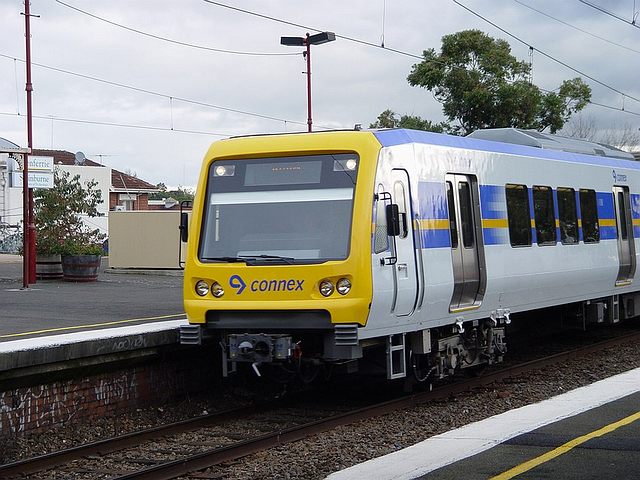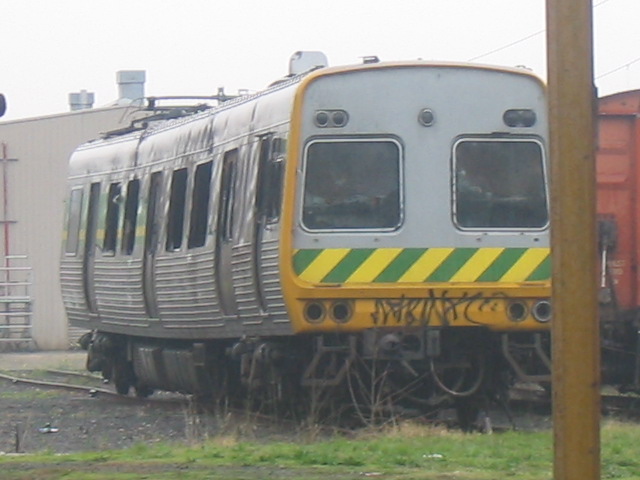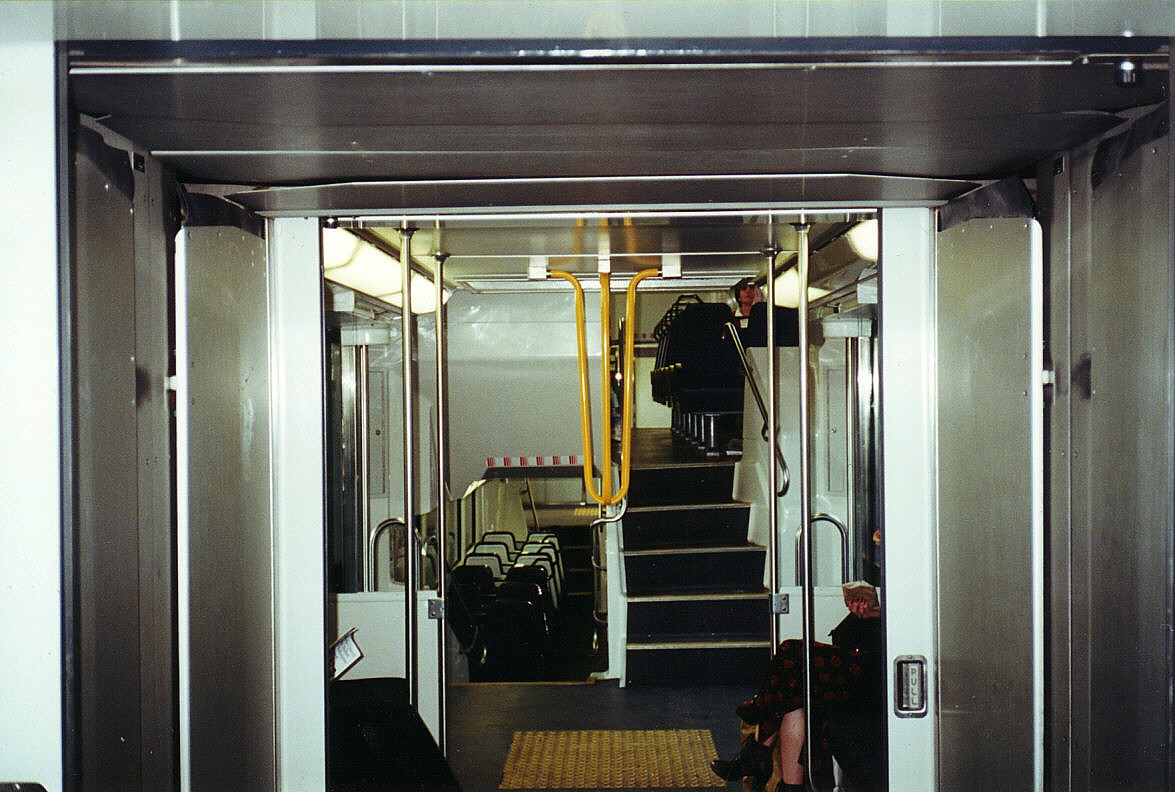|
Connex Melbourne
Connex Melbourne was a train operator in Melbourne, Australia. Formed in July 1998 as Hillside Trains, a business unit of the Public Transport Corporation, it was privatised in August 1999 becoming a subsidiary of Veolia Transport, Connex. In April 2004, it became the sole operator of Railways in Melbourne, Melbourne suburban rail services, taking over the services of M-Train, M>Train. When the franchise was re-tendered, it was awarded to Metro Trains Melbourne from November 2009. History In October 1997, in preparation for privatisation, it was announced the Public Transport Corporation's suburban rail operations would be split into two business units, M-Train, Bayside Trains and Hillside Trains. PTC's tram operations was also split in preparation for privatisation. The Melbourne Transport Enterprises consortium, consisting of CGEA Transport Asia Pacific Holdings (CTAP) (a subsidiary of CGEA, later known as Veolia Transport, Connex), Alstom, GEC Alsthom Australia Ltd (later k ... [...More Info...] [...Related Items...] OR: [Wikipedia] [Google] [Baidu] |
Comeng (train)
The Comeng ( ) is a class of electric multiple unit (EMU) operating on the Railways in Melbourne, suburban railway network of Melbourne. Built by their namesake Commonwealth Engineering (abbreviated as Comeng), the trains were introduced in 1981 as a replacement for the Tait (train), Tait and Harris (train), Harris trains. In total, 190 three-car trainsets were built, although only 110 remain in service and are expected to be retired by 2030. The fleet underwent two major refurbishments. The first, a mid-life refurbishment, was carried out from 2000 to 2003 by Alstom and Downer Rail, EDi Rail. The second, named the Comeng Life Extension Project, completed between 2017 and 2021, aimed to extend the trains' lifespan to meet their gradual replacement by the High Capacity Metro Train, High Capacity Metro Trains and the X'Trapolis 2.0 trains. Alongside these upgrades, a number of minor improvement programs were also conducted on the trains to further enhance their efficiency, safety, ... [...More Info...] [...Related Items...] OR: [Wikipedia] [Google] [Baidu] |
Mernda Railway Line
The Mernda line is a Commuter rail, commuter railway line on the Railways in Melbourne, Melbourne metropolitan railway network serving the city of Melbourne in Victoria (state), Victoria, Australia. Operated by Metro Trains Melbourne, the line is coloured red and is one of the two lines that constitute the Metro Trains Melbourne#Clifton Hill Group, Clifton Hill group. It is the city's eighth longest metropolitan railway line at . The line runs from Flinders Street railway station, Flinders Street station in central Melbourne to Mernda railway station, Mernda station in the north, serving 29 stations via Clifton Hill railway station, Clifton Hill, Reservoir railway station, Reservoir, Epping railway station, Melbourne, Epping, and South Morang railway station, South Morang. The line operates for approximately 19 hours a day (from approximately 5:00 am to around 12:00 am) with 24-hour service available on Friday and Saturday nights. During peak hour, headways of up to 7.5 minutes ... [...More Info...] [...Related Items...] OR: [Wikipedia] [Google] [Baidu] |
Ballarat North Workshops
Ballarat North Workshops is a railway engineering facility owned by Alstom in Ballarat, Victoria, Australia. It occupies 5.5 hectares of land beside the junction of the Mildura railway line, Mildura and Serviceton railway line, Serviceton railway lines. History The workshops were opened in April 1917 by the Victorian Railways. It opened in response to political pressures from provincial groups for decentralisation, with the Victorian Railways preferring the cheaper option of expanding the existing Newport Workshops in suburban Melbourne. The main work carried out was repairs and maintenance of existing wagons and locomotives, but from 1919-22 thirteen new steam locomotives were also built - eight Victorian Railways Dd class, DD class (1038 - 1042, 1050 - 1052) and five Victorian Railways A2 class, A2 class (1073 - 1077) steam locomotives were also built. By the 1960s goods wagons were also being built, and by the 1980s work was also being carried out on Melbourne suburban ele ... [...More Info...] [...Related Items...] OR: [Wikipedia] [Google] [Baidu] |
Australian Railway History
''Australian Railway History'' is a monthly magazine covering railway history in Australia, published by the New South Wales Division of the Australian Railway Historical Society on behalf of its state and territory Divisions. History and profile It was first published in 1937 as the ''Australasian Railway and Locomotive Historical Society Bulletin''. It was renamed ''ARHS Bulletin'' in 1952. In January 2004, the magazine was re-branded as ''Australian Railway History''. Historically, the magazine had a mix of articles dealing with historical material and items on current events drawn from its affiliate publications. Today, it contains only historical articles, two or three of them being in-depth. References Publication details *''Australian Railway History: bulletin of the Australian Railway Historical Society'' Redfern, New South Wales Vol. 55, no. 795 (Jan. 2004)- *''Bulletin (Australian Railway Historical Society The Australian Railway Historical Society (AR ... [...More Info...] [...Related Items...] OR: [Wikipedia] [Google] [Baidu] |
4D (train)
The 4D was a prototype bilevel rail car, double deck electric multiple unit built for the Public Transport Corporation in Victoria, Australia, for operation on the Railways in Melbourne, Melbourne railway system. It remains the only double deck train to have ever operated in Melbourne. The train's name stood for "Double Deck Development and Demonstration." Depending on sources, the intention was for this train to be the demonstration unit for a future order of either 20 or 50 extra sets, had the tests been successful. Design A tender for the design and construction of 19 double-deck trains was opened on 24 November 1989. The number of carriages to be built was at the discretion of the builder, however it had to comply with capacity and length requirements. By 11 April 1990, when the tender was closed, a number of tenders were received, including from Commonwealth Engineering, Comeng and UGL Rail, A Goninan & Co. However, the project was stopped by the Government of Victoria, S ... [...More Info...] [...Related Items...] OR: [Wikipedia] [Google] [Baidu] |
Hitachi (Australian Train)
The Hitachi (also known as Silver trains, Martin & King or Stainless Steel) is an electric multiple unit train that operated on the Melbourne suburban railway network between 1972 and 2014. Electrical equipment was supplied by Commonwealth Engineering, to designs by Hitachi of Japan, leading to their official name today, although no Hitachi-supplied components were used in their construction. They were the last suburban trains in Melbourne without air conditioning. A total of 355 carriages were built between 1972 and 1981, including a replacement carriage for one written off while the fleet was still being delivered. Configuration Based on a successful trial of longer Harris trailer cars built between 1967 and 1971, the Hitachi used carriages that were long, an increase from the standard length of earlier suburban cars. The revised carriage configuration enabled a six-car Hitachi to seat 560 passengers, up from 540 for a seven-car Harris, and allowed a maximum load of 1,500 ... [...More Info...] [...Related Items...] OR: [Wikipedia] [Google] [Baidu] |
D2 0371E2E1R1 Comengtooronga
D, or d, is the fourth letter of the Latin alphabet, used in the modern English alphabet, the alphabets of other western European languages and others worldwide. Its name in English is ''dee'' (pronounced ), plural ''dees''. History The Semitic letter Dāleth may have developed from the logogram for a fish or a door. There are many different Egyptian hieroglyphs that might have inspired this. In Semitic, Ancient Greek and Latin, the letter represented ; in the Etruscan alphabet the letter was archaic but still retained. The equivalent Greek letter is delta, Δ. The minuscule (lower-case) form of 'd' consists of a lower-story left bowl and a stem ascender. It most likely developed by gradual variations on the majuscule (capital) form 'D', and is now composed as a stem with a full lobe to the right. In handwriting, it was common to start the arc to the left of the vertical stroke, resulting in a serif at the top of the arc. This serif was extended while the rest of ... [...More Info...] [...Related Items...] OR: [Wikipedia] [Google] [Baidu] |
The Age
''The Age'' is a daily newspaper in Melbourne, Australia, that has been published since 1854. Owned and published by Nine Entertainment, ''The Age'' primarily serves Victoria (Australia), Victoria, but copies also sell in Tasmania, the Australian Capital Territory and border regions of South Australia and southern New South Wales. It is delivered both in print and digital formats. The newspaper shares some articles with its sister paper ''The Sydney Morning Herald''. ''The Age'' is considered a newspaper of record for Australia, and has variously been known for its investigative reporting, with its journalists having won dozens of Walkley Awards, Australia's most prestigious journalism prize. , ''The Age'' had a monthly readership of 5.4 million. , this had fallen to 4.55 million. History Foundation ''The Age'' was founded by three Melbourne businessmen: brothers John and Henry Cooke (who had arrived from New Zealand in the 1840s) and Walter Powell. The first editi ... [...More Info...] [...Related Items...] OR: [Wikipedia] [Google] [Baidu] |
The Daily Telegraph
''The Daily Telegraph'', known online and elsewhere as ''The Telegraph'', is a British daily broadsheet conservative newspaper published in London by Telegraph Media Group and distributed in the United Kingdom and internationally. It was founded by Arthur B. Sleigh in 1855 as ''The Daily Telegraph and Courier''. ''The Telegraph'' is considered a newspaper of record in the UK. The paper's motto, "Was, is, and will be", was included in its emblem which was used for over a century starting in 1858. In 2013, ''The Daily Telegraph'' and ''The Sunday Telegraph'', which started in 1961, were merged, although the latter retains its own editor. It is politically conservative and supports the Conservative Party (UK), Conservative Party. It was moderately Liberalism, liberal politically before the late 1870s.Dictionary of Nineteenth Century Journalismp 159 ''The Telegraph'' has had a number of news scoops, including the outbreak of World War II by rookie reporter Clare Hollingworth, desc ... [...More Info...] [...Related Items...] OR: [Wikipedia] [Google] [Baidu] |
National Express
Mobico Group, formerly National Express Group, is a British multinational public transport company with headquarters in Birmingham, England. Domestically it currently operates bus and coach services under brands including National Express. The company also operates transport services including trains abroad: in the Republic of Ireland, United States, Canada, Spain, Portugal, Malta, Germany, Bahrain, Morocco, Qatar, United Arab Emirates and South Korea, and long-distance coach services across Europe. It is listed on the London Stock Exchange and is a constituent of the FTSE 250 Index. History Early years In 1972, the state-owned National Bus Company decided to bring together the scheduled coach services operated by its bus operating companies in the United Kingdom under one brand. Sir Frederick Wood, a prominent businessman and industrialist, was asked to oversee the creation of this new business model and led the group as its chairman from 1972 to 1978. Initially brande ... [...More Info...] [...Related Items...] OR: [Wikipedia] [Google] [Baidu] |
GB Railways
GB Railways was the parent company of a number of Train operating company, train operating companies, running the Anglia Railways franchise from January 1997 and launching Hull Trains and GB Railfreight. GB Railways was also involved in the management of the Estonian rail company Edelaraudtee and had an investment in Great Southern Rail (Australia), Great Southern Rail in Australia. The company was acquired by FirstGroup in August 2003. History GB Railways was formed in October 1996 by entrepreneurs with diverse backgrounds initially to bid for rail franchises in the United Kingdom during the privatisation of British Rail. After being awarded the Anglia Railways, Anglia franchise in 1996, GB Railways was listed on the Alternative Investment Market in January 1997. In October 1997 as part of the ''Great Southern Railway Consortium'' with Legal & General, Macquarie Bank, RailAmerica, G13 Pty Ltd and Serco, it acquired the interstate passenger services of Australian National ... [...More Info...] [...Related Items...] OR: [Wikipedia] [Google] [Baidu] |






